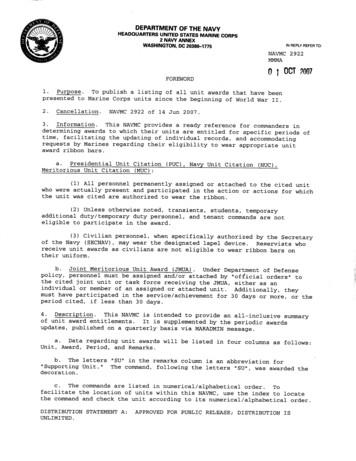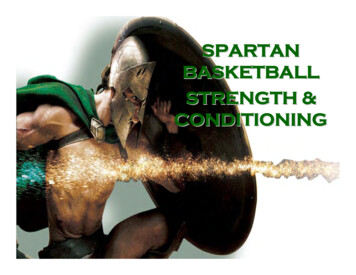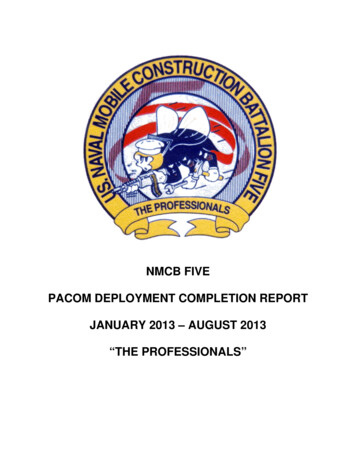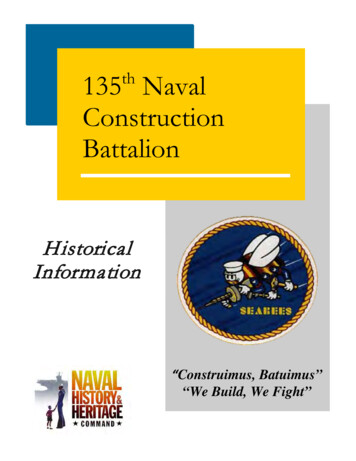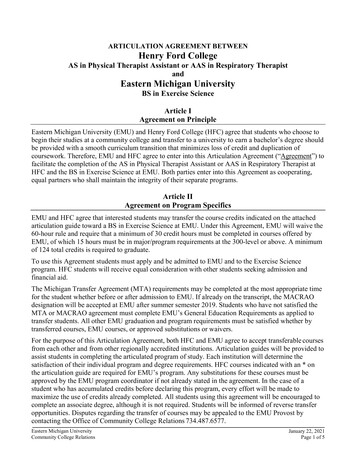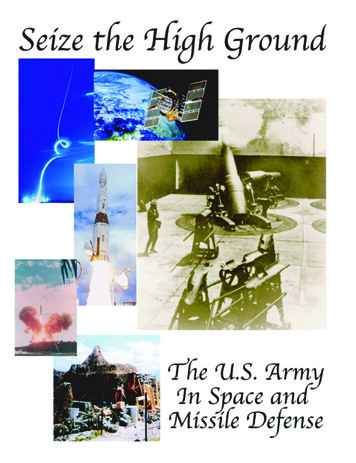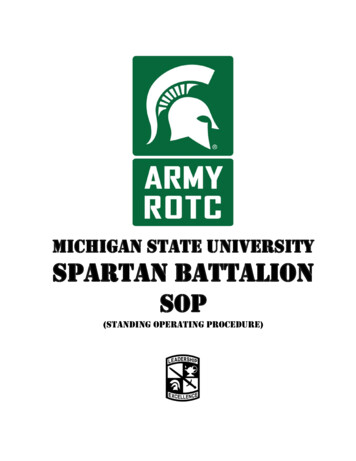
Transcription
Michigan State UniversitySpartan BattalionSOP(Standing Operating Procedure)
TABLE OF CONTENTS1. Introductiona. Welcome Letterb. Missionc. MSU ROTC History2. Program Overviewa. Commissioning/Professional Military Education (PME) Requirementsb. Basic Coursec. Advanced Coursed. Cadet Summer Training (CST)(1) Basic Camp(2) Advanced Campe. Army Physical Fitness Test (APFT)f. Army Body Fat Composition Program (ABCP)3. Academicsa. MS110/120b. MS210/220c. MS310/320d. MS410/420e. MS490f. Defense and Leadership Studies Minorg. Academic Standard4. Financial Assistancea. National Board Scholarshipsb. On-Campus Scholarshipsc. Minuteman Scholarshipsd. Guaranteed Reserve Forces Duty (GRFD) Scholarshipse. MSU ROTC Room and Board Scholarshipsf. STEM Scholarshipsg. Nursing Scholarshipsh. CLIP-Bi. GoArmyEd5. Simultaneous Membership Program (SMP)a. United States Army Reserve (USAR)/Army National Guard (ARNG)6. Cadet Actionsa. Contractingb. Extensions of Benefitsc. Changes of Majord. Migratione. Transfer of School7. Accessionsa. Componentb. Branchc. Spartan Battalion OML8. Summer Training Opportunities
a. Cultural Understanding and Language Proficiency (CULP)b. Operation Global Officer (GO)c. Airborned. Air Assaulte. Northern Warfaref. Cadet Troop Leader Training (CTLT)9. Clubsa. Ranger 1b. Pathfindersc. Running Clubd. Color guarde. Marksmanship10. Eventsa. Army 10-milerb. Alex’s Great State Racec. German Armed Forces Proficiency Badge (GAFB)d. Adopt a Schoole. LEADsf. Bold Warrior Challenge11. Cadet Chain of Commanda. Positions/Duties and Responsibilities12. Cadet Awards13. Policy Letters14. AAR Format
Welcome to the Spartan Battalion,Whether you have a personal commitment to pursue an Officers’ commission,are simply enrolling to gain leadership training and experience, or you just wantto learn something about the military, we are pleased to have you with us.We prepared this handbook to assist you in understanding how the programis organized. Keep it with you as a reference and become familiar with itscontents.The goal of the MSU Army ROTC program is to develop leaders andcommission qualified Second Lieutenants for the United States Army. Ourcourses and extracurricular activities build to achieve this end. We believe youwill find the program challenging, rewarding, and fun.Each member of the department stands ready to assist in making yourparticipation in Army ROTC a productive and enjoyable experience. Ourprogram, like our Army, consists of individuals with different personal goals andobjectives. We encourage students to discuss their goals with our Cadre so thatwe can help you achieve them.Welcome to the program and best of luck in everything you do at MSU.GO GREEN!Department ofMilitaryScienceArmy ROTC229 Demonstration HallRoom 113East Lansing, MI48824-1028517-355-1913Fax: 517-353-8981armyrotc.msu.eduJASON O. DEGEORGELTC, AVChairperson
INTRODUCTIONMissionUnited States Army Cadet Command (USACC). The U.S. Army Cadet Commandpartners with universities to recruit, educate, develop, and inspire Senior ROTC Cadetsin order to commission officers of character for the Total Army; and partners with highschools to conduct JROTC in order to develop citizens of character for a lifetime ofcommitment and service to the nation.7th Brigade, USACC. 7th Brigade commissions officers to meet the Army's leadershiprequirements; and provides a citizenship program that motivates young people to bestrong leaders and better citizens.MSU ROTC, 7th Brigade, USACC. During this academic year Michigan StateUniversity Army ROTC, 7th Brigade, Cadet Command will recruit, retain, and developCadets of character in order to commission future U.S. Army leaders capable of thrivingin chaos who are dedicated to lifelong service to our communities.MSU ROTC HistoryThe origin of military instruction at MSU dates to the founding of Michigan AgriculturalCollege (MAC) in 1855. For nearly thirty years MAC, like subsequent land-grantcolleges, required all its students to receive some form of instruction in the art of militarytactics. The year 1861 saw the first military unit on the campus of MAC. The unit,organized by a member of the faculty, was known as the “Plowboy Guards”. In the fallof 1861, a recruiting Officer from the Union Army appeared seeking men withknowledge of science and engineering. The senior class was excused two monthsbefore commencement to enable the members to answer Lincoln’s call to arms.During the period 1862 to 1917, the military program at the newly renamed MichiganState College offered instruction in infantry tactics and sponsored an infantry band. TheMilitary Department, the forerunner of today’s Department of Military Science, wasestablished in 1884 and the first active duty Professor of Military Science and tacticsreported for duty in November of that year. This early Military Department expandedthe formal instruction of courses in military art, and introduced equestrian training andapplied Soldiering skills.The college Military Department became part of the Reserve Officers Training Corps(ROTC) as established by the National Defense Act of 1916. By 1918 there wereInfantry, Cavalry, Coast Artillery, and Band units established at MSU. DemonstrationHall was constructed during the next decade to accommodate the ROTC program andprovide a riding arena for instruction in horsemanship.3
In June of 1922, the first class of twenty Cadets was commissioned as SecondLieutenants in the United States Reserve under the current ROTC concept.Demonstration Hall has been the home for ROTC since its completion in 1927.By 1941 the Cadet regiment was over 3,000 and one third of the junior and seniorclass was enrolled in Advanced ROTC. In 1954 all Officers received academic rankfrom the university as Assistant Professors. Prior to this only the Professor of MilitaryScience held academic rank. In 1962 mandatory enrollment in ROTC for freshman andsophomores ended and enrollment dropped dramatically.The Department of Military Science has undergone many generations of change andits history reflects the political, social, and economical realities of the times. Graduatesof the program form a core of distinguished and successful alumni of the university inboth the civilian and military community.Today, the Department of Military Science at Michigan State University continues tocommission highly qualified Cadets as Second Lieutenants in the United States Army,the Army National Guard, and the Army Reserve.PROGRAM OVERVIEWThe program provides education in leadership and military skills through coursesoffered by the Department of Military Science. The Army ROTC program providespreparation for leadership in a profession, either military or civilian.Commissioning/Professional Military Education (PME) RequirementsCadets must meet all PME requirements in order to commission. U.S. Army CadetCommand PME commissioning requirements is in an outline below. Substitutions,deferments, waivers and exemptions to the PME requirements are in Chapter 3 of thisregulation.a. Baccalaureate degree. Cadets must achieve a cumulative GPA of 2.0 on a 4.0 scaleor its equivalent and possess a baccalaureate degree conferred by an accredited 4-yeardegree granting institution.b. Advanced Course. Cadets must complete the Advanced Course, (MSL 310, MSL320, MSL 410, MSL 420, and Leadership Labs) and CLC in order to receive acommission.c. Military History Course. Prior to commissioning, Cadets will complete a one-semesteror equivalent college-level course in American military history offered by the college4
history department or offered by the ROTC Department. See Table 1 below for the listof MSU Courses that meet this requirement.d. Staff Ride or Battlefield Tour. A staff ride or battlefield tour happens in addition to theMilitary History Course PME requirement. The PMS will ensure Cadets participate in astaff ride or battlefield tour prior to commissioning. This staff ride or battlefield tour willhappen in conjunction with the ROTC American Military History Course or as a separateactivity during the school year. The intent is to involve Cadets in a formal battle analysis.Cadets must properly prepare and conduct the necessary preliminary study prior to theevent, participate in the event and complete a battle analysis paper or briefing in orderto meet this requirement.e. Combat Water Survival Test (CWST). CWST is a non-waiverable PME requirementthat all Cadets must successfully complete in order to commission.f. English Language Proficiency. In order to commission, a Cadet whose nativelanguage or primary language spoken in the home is other than English must score a90 on the ECLT and have an OPI score of 2 /2.Basic CourseThe Basic Course, normally completed in the freshman and sophomore years,provides the student a general knowledge of the military’s role in our society and themissions of the Army. Subjects include leadership, land navigation, marksmanship,military history, and basic military skills. Students enroll in one military science courseeach semester. It is possible for a sophomore to complete the Basic Course in oneyear through prior arrangement with the department. No military obligation incurs fornon-scholarship students participating in or completing the Basic Course.Advanced CourseThe Advanced Course is the professional phase of the ROTC training program.Upon satisfactory completion of required ROTC courses and the professional militaryeducation (PME) component, the student is eligible for a commission as a SecondLieutenant in the Active Duty Army, the U.S. Army Reserve, or the Army NationalGuard.The professional phase includes courses in leadership skills, training, personnelmanagement, ethics, military justice, and military tactics. During the two years of theAdvanced Course, students enroll in one military science course and one lab per term.The PME component consists of two essential parts: a bachelor’s degree and at leastone undergraduate course from three designated fields of study. You must take acourse in military history, which Michigan State University offers. See your militaryscience instructor for specifics in PME. Attendance at one scheduled field training5
exercise (FTX) happens each semester, and all students must meet Army physicalfitness and weight control standards. A four-week Cadet Leadership Course (CLC) isnormally attended in the summer between the junior and senior years.Cadet Summer Training (CST)Basic CampThe Cadet Summer Training Basic Camp is the premier leadership program of itskind in the United States. An intense four-week introduction to Army life and leadershiptraining of the Reserve Officers' Training Corps, the aim of the course is to motivate andqualify Cadets for entry into the Senior ROTC program.Basic Camp is for college students, typically between their sophomore and junioryears. Upon successful completion of the course, graduates can take part in ROTC attheir college as a third-year student in the four-year program.While attending Basic Camp at Fort Knox, Kentucky, Cadets gain an experience thatruns the gamut of Army life and the responsibilities of being an officer. The courseinstills confidence and decision-making abilities to become a leader, in the Army and inlife.The four weeks of Basic Camp are mentally grueling and physically taxing. Thereward of graduation and meeting ROTC standards is the opportunity to enroll in theworld's greatest leadership program.Graduation from Basic Camp has been the first step in many successful officers'careers. Graduates have gone on to lead America's sons and daughters in fighting topreserve American democracy and freedoms or in civilian life in the boardrooms andoffices of American business.Advanced CampThe Cadet Summer Training Advanced Camp happens annually at Fort Knox,Kentucky. The U.S. Army's largest training exercise, Advanced Camp is the U.S. ArmyCadet Command's capstone training event.The purpose of the course is to train U.S. Army ROTC Cadets to Army standards, todevelop their leadership skills, and to evaluate their officer potential. Most Army Cadetsattend Advanced Camp between their junior and senior undergraduate years afterhaving contracted to join the Army. Successful completion of Advanced Camp is aprerequisite to becoming an Army officer through ROTC.6
The 29-day course starts with individual training and leads to collective training,building from simple to complex tasks. This building-block approach permits integrationof previously learned skills into follow-on training. This logical, common-sense trainingsequence happens for each training cycle. Every day at Advanced Camp is a day oftraining.Land Navigation training happens early in the training cycle for the Cadets to be fullysuccessful in the tactical training that follows. The Land Navigation evaluation consistsof three events totaling 100 points. The written examination is worth 20 percent. Theday Land Navigation test is worth 50 percent. The night Land Navigation test is worth 30percent. Each cadet must earn 70 percent on each test to pass this event. A passingscore in Land Navigation is a criterion for success.This includes rappel training, the Slide For Life, Log Walk/Rope Drop, and confidenceand obstacle courses. Confidence Training challenges the Cadets' physical courage,build confidence in personal abilities, and help them overcome fear. At the rappellingsite, each cadet executes one 17-foot rappel and several 37-foot rappels. Cadetsdemonstrate confidence in their ability to overcome fear of heights by executing theConfidence/Obstacle Course, Log Walk/Rope Drop and Slide For Life.Field Leaders Reaction Course (FLRC) develops and evaluates leadership, andbuilds teamwork early in the training cycle. Course administration happens using theestablished cadet organization and chain of command. Cadet leadership potential isassessed by committee evaluators. Cadets have the opportunity to get early feedbackon their leadership strengths, weaknesses, styles and techniques.Chemical, Biological Radiological, Nuclear, Explosive Training teaches Cadets howto administer a nerve agent antidote, how to protect themselves from chemical andbiological contamination using their assigned protective mask, decontaminatethemselves and individual equipment using chemical decontaminating kits and how toreact to chemical or biological hazard/attack. In addition, Cadets must go through theCS gas chamber.Advanced Camp familiarizes Cadets with the operation and employment of infantrysquad weapons and call for fire grid missions. The Cadets train in the fundamentals ofoperation and engaging of targets and emplacement of crew-served weapons such asthe M-249, M203, and M136. Advanced Camp teaches Cadets a basic understandingof cultural matters and how cultural awareness will facilitate mission success. Cadetslearn how to conduct bi-lateral discussions with local officials, how to conduct a knockand search mission and how to defuse volatile situations using an interpreter.Cadets develop confidence in their ability to react properly to battlefield wounds.Through hands-on training and evaluation, Cadets learn critical first aid skills.7
In the first block of instruction in maneuver at Advanced Camp, Cadets learnindividual battlefield skills, combat movement techniques and procedures necessary forsubsequent tactical training at the squad level. Maneuver training is a vehicle to teachand evaluate leadership. It introduces conditions of stress that parallel those found incombat. Tactical training introduces new skills, provides performance-orientedreinforcement opportunities and increases the degree of difficulty and sophistication oftraining events. Cadets learn the skills necessary to function in a Tactical Training AreaThis building-block approach provides the best opportunity for Cadets to learn and forcadre to assess leadership potential.Squad Situational Training Exercise: Squad STX is a four-day, two-phase event. Thefirst day, the squad-training phase, trains squad battle drills and collective tasks. Thelast three days, the Squad STX lane phase, evaluates leadership using tacticalscenarios. Each cadet receives two formal evaluations of his/her performance as asquad leader during this phase. Squad operations build on and reinforce all previousinstruction. Cadets use knowledge of land navigation, terrain analysis, weaponssystems and all individual training previously presented.Patrolling Situational Training Exercise: Patrolling STX is a two-day event thatprovides Cadets practical experience in leading Soldiers at the section level in achallenging, realistic and fluid environment. On the first day, Cadets undergo trainingand then during the last three days they participate in an exercise where they receive anevaluation. Cadre gives developmental feedback to all levels of leadership. PatrollingSTX builds on and reinforces all previous instruction received during the course. Theevent ends with a 10K foot march.Army Physical Fitness Test (APFT)Military leaders have always recognized that the effectiveness of Soldiers dependslargely on their physical condition. Unified Land Operations place a premium on theSoldier’s strength, stamina, agility, resiliency, and coordination. Victory—and even theSoldier’s life—so often depend upon these factors. To march long distances in fightingload through rugged country and to fight effectively upon arriving at the area of combat;to drive fast-moving tanks and motor vehicles over rough terrain; to assault; to run andcrawl for long distances; to jump in and out of craters and trenches; and to jump overobstacles; to lift and carry heavy objects; to keep going for many hours without sleep orrest - all these activities of warfare and many others require superb physicalconditioning.Physical readiness is the ability to meet the physical demands of any combat or dutyposition, accomplish the mission, and continue to fight and win. Physical readinesstraining provides the physical component that contributes to tactical and technicalcompetence, and forms the physical foundation for all training. Commanders andsupervisors must establish PRT programs consistent with the requirements in Army8
Regulation 350-1, with their unit missions, and with this field manual (TC 7-22). Cadetsmust meet the physical fitness standards set forth in Army Regulation 350-1 and in theArmy Physical Fitness Test (APFT).Army Body Fat Composition Program (ABCP)Cadets must maintain a high level of physical readiness in order to meet missionrequirements. Body composition is one indicator of physical readiness that is associatedwith an individual’s fitness, endurance, and overall health. Individuals with desirablebody fat percentages generally exhibit increased muscular strength and endurance, areless likely to sustain injury from weight bearing activity, and are more likely to perform atan optimal level. Cadets will meet Army body composition standards prescribed in ArmyRegulation 600-9, for the individual and collective benefit to themselves, their unit, andthe entire Army.ACADEMICSThe Department of Military Science is the official certifying agency for a commissionand is responsible for development of professional skills and standards. For thesereasons, it is necessary that there is a strict grading. The grading criteria for eachcourse is in the syllabus and provided to each student at the beginning of the course.Required field trips, special lectures, and attendance shows in the grading for the termin which they are given.a. Each Military Science course consists of earning points through examination, classparticipation, or other graded work as be determined by the instructor.b. Numerical grades for Military Science courses are as described in the coursesyllabus.c. Contracted Cadets must attend leadership labs. Enrolled or participating Cadetsare encouraged to participate in leadership labs. (Refer to your instructor’s classsyllabus for details on lab attendance).d. All contracted Cadets participate in physical fitness training program. Enrolled andparticipating Cadets are encouraged to participate in physical training.e. Only instructors may excuse Cadets from training/classroom instruction.MS110/120MS 110 Army Leadership and Officer Development9
Duties and responsibilities of the Army Officer and Non Commissioned Officer(NCO). Organizational structure of the Army, Army Reserve, and National Guard. TheArmy’s role in joint operations. Introduction to Army values, leadership, customs, andtraditions.MS 120 Introduction to Army Leadership & Problem SolvingFundamentals of basic Army leadership. Military problem solving process. Militarybriefing and writing skills. Goal setting and time management. Introduction to the Army'sdevelopmental counseling program.MS210/220MS 210 Values and Ethics of Army LeadersApplication of military case studies. Critical dilemmas in combat situations and theethical decisions Army leaders make to ensue mission success. Understanding how toimprove Army organizations and Soldier performance. Introduction to the Army’sleadership development program, battle drills, land navigation, and combat decisionmaking.MS 220 Challenges in Army LeadershipApplication of military case studies. Recognizing challenging situations for militaryleaders and units. Applying sound ethical leadership practices to implement decisions.Understanding basic military small unit tactics.MS310/320MS 310 Leading and Problem Solving in Army UnitsPlanning and executing military activities in small Army units. Recognizing andanalyzing problems in challenging situations. Implementing the skills required tocommunicate decisions and supervise subordinates. Applying fundamentals of mapreading and land navigation.MS 320 Army Unit Tactics and leadershipFundamentals of military Tactics and battle drills. Applying troop leadingprocedures to military tactical operations. Implementing skills and making decisions tolead small Army units on the battlefield. Integrate terrain analysis into military planningand operations.10
MS410/420MS 410 Adaptive Army LeadershipApplication of military case studies. Skills and attributes military leaders use tomake decisions in combat situations. Practical exercises in problem solving and crisiscounseling. Fundamentals of Army Training Management, the military justice system,and the law of land warfare.MS 420 Army Leadership in a Complex WorldApplication of military case studies to the principles of the law of land warfare, andrules of engagement in the face of international terrorism. Importance of ethics inmilitary leadership. Integration of the media into military operations. Evaluation ofinteraction with nongovernmental organizations, civilians, and host nation support onthe battlefield.MS490Independent Study in Military ScienceThis course does not have a set topic or instructor. Cadets choose a military-relatedtopic that interests them. Topics accepted in the past include: Historical Battles and CampaignsFuture Combat SystemsAnalysis of Current EventsMilitary Reading AnalysisHistory RequirementCOURSE NO.OFFEREDHST 302HST 304HST 325HST 326HST 328HST 365HST 390HST 395HST 414TITLERevolutionary AmericaThe American Civil WarU.S. Foreign Relations to 1914U.S. Foreign Relations Since 1914Military History of the U.S. 1900-PresentThe Vietnam WarHistory of International RelationsThe Social History of WarWorld War II: Causes, Conduct & Cons.11CREDITS333333333
Defense Studies and Leadership MinorThe Minor in Defense Studies and Leadership, given by the Department of History,provides students with a broad perspective on the military with analysis of all servicebranches of the Armed Forces from a historical and social scientific perspective. It alsoprepares current Cadets for active duty service.The minor is available as an elective to students who participate in bachelor’s degreeprograms at Michigan State University. With the approval of the department andcollege that administers the student’s degree program, the courses that will satisfy theminor may also be used to satisfy the requirements for the bachelor’s degree. Cadetswho plan to complete the requirements for the minor should consult an undergraduateadvisor in the Department of History.Financial AssistanceScholarship OverviewFour, three-and-a-half-, three, two-and-a-half, and two-year Army ROTCscholarships may be available and awarded on a competitive basis. Thesescholarships will pay for full tuition (some can be used for room and board), as well asrequired fees, and provide 600 per semester for textbooks, supplies, and equipment.Scholarship students also receive the 300-500 (based on MS level) per monthsubsistence allowance for up to ten months each school year the scholarship is ineffect. Pay is also received while attending the four-week Cadet Leadership Coursebetween MS III and MS IV school year. Scholarship students must meet universityadmission criteria, pass the Army Physical Fitness Test (APFT), meet Army Body FatComposition standards, and pass a DOD medical exam. General qualifications for ascholarship are: U.S. citizen upon acceptance.Minimum 17 years of age.Have taken the ACT or SAT no later than November of the year you apply.Participate in leadership extracurricular and athletic activities.Meet required medical and fitness standards.Be under 30 years old on December 31 of the year you expect to graduate andreceive commission.Gain admission to MSU.Be accepted by one of the Army ROTC host college or universities, or a crossenrollment school.Pursue a Department of the Army approved academic discipline.Agree to accept a commission as an active duty Officer.12
National Board ScholarshipsNational Board Scholarships are awarded competitively to High School Students.The board meets three times in the winter and fall of the High School Student’s Senioryear. It awards 3 and 4-year scholarships. Standards: Have a high school GPA of at least 2.50 Score a minimum of 1000 on the SAT (math/verbal) or 19 on the ACT (excludingthe required writing test scores)On-Campus ScholarshipThe Spartan Battalion can request scholarships for cadets who are highly qualified.These Scholarships are generally 2 and 3-year scholarships. On-campus scholarshipsmay be awarded on a competitive basis. The qualifications are the same as above and: Have at least three years (for a three-year scholarship) or two years (for a twoyear scholarship) remaining for baccalaureate or graduate degree. Have satisfactory grades in all academic courses and ROTC courses (if alreadyenrolled in ROTC). Minimum of 2.5, but preferably a 3.0 cumulative GPA.Minuteman ScholarshipsMinuteman Scholarships are similar to National Board Scholarships. NationalGuard State Adjutants General (TAG), USAR Ambassadors, and States’ Civilian Aidesto the Secretary of Defense nominate Students for Minuteman Scholarships. Thescholarships are 3 and 4-year scholarships and provide the same benefits as NationalBoard Scholarships. There are two differences: Minuteman Scholarship Winners must serve in the ARNG or USARSimultaneous Membership Program (SMP)Must access into the ARNG or the USAR.Guaranteed Reserve Forces Duty (GRFD) ScholarshipsGRFD Scholarships are similar to 2 and 3-year on-campus scholarships. However,GRFD winners must serve in the ARNG or USAR Simultaneous Membership Program(SMP), and they must access into the ARNG or the USAR.MSU ROTC Room and Board Scholarships13
Michigan State University graciously provides the Department of Military Science anumber of Room and Board Scholarships to provide to Michigan State UniversityStudents in our program. The program awards the room and board scholarships on acompetitive basis, annually. The scholarship is 10,000 per year awarded.Nursing ScholarshipsNursing students who are also Army ROTC Cadets can benefit from hands-on,unique nursing opportunities while receiving financial assistance for college. You willgain valuable leadership experience and management training that can benefit you ineither a private sector or military nursing career. Army ROTC program offers two-,three- or four-year scholarships for undergraduate nursing students.CLIP-BThe U.S. Army announced Aug. 13, 2008 a financial incentive pilot program forrecruiting new college Reserve Officer Training Corps (ROTC) Cadets who takecourses in critical foreign languages, such as Arabic, Persian-Farsi, and ChineseMandarin, as well as commit to entering the regular Army, the Army Reserve, or theArmy National Guard as a commissioned Officer.CLIP-B is aimed at promoting the study of languages and cultural studies that are ofimportance to the Army. Language and cultural studies bonuses are graduated inincreasing amounts and in sufficient dollar amounts to provide a lucrative incentive topersuade Cadets to begin to gain Culture and Foreign Language competence.GoArmyEdLead by example. An educated Soldier is the best asset of the Army. Pursue youreducational dreams by using GoArmyEd to research your educational options, registerfor classes and to monitor your educational progress. GoArmyEd is used by all Soldiers,Active Component, Army National Guard and the Army Reserves and is managed byHeadquarters, Army Continuing Education System (ACES), Army Human ResourcesCommand at Fort Knox, Kentucky.GoArmyEd is the virtual gateway for you to request Tuition Assistance (TA) online,anytime for both classroom and distance learning college courses. GoArmyEd is adynamic online portal that automated many of the paper-based processes historicallyconducted with your Army Education Counselor. GoArmyEd is your one-stop locationfor managing your college education and using TA benefits. GoArmyEd gives youaccess to thousands of regionally accredited colleges and universities and over 1,000available degree plans. GoArmyEd is used by:14
Cadets to pursue their postsecondary educational goalsArmy Education Counselors to provid
Department of Military Science Army ROTC 229 Demonstration Hall Room 113 East Lansing, MI 48824-1028 517-355-1913 Fax: 517-353-8981 armyrotc.msu.edu
